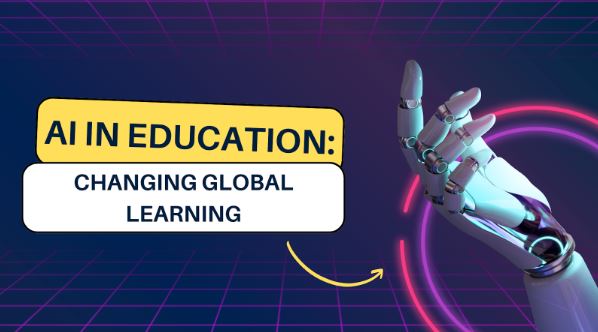
With AI’s power to personalize and enhance learning, there are never before seen possibilities for student involvement and process optimization in the classroom.
Integrating AI tools and platforms into educational systems improves educational content delivery and consumption significantly.
The availability of online college homework help at StudyBay.com and similar services provides a convenient solution for college students who need help with college homework.
These platforms serve as a college assignments helper, making academic challenges more manageable for students navigating their courses.
This article delves into the current impact, potential applications, and challenges of AI in the global education sector.
The Current State of AI in Education
The revolutionary effect that AI is having on educational practices is demonstrated by its fast adoption in the field.
With the help of some eye-opening numbers, here is a survey of where artificial intelligence is at in the classroom right now:
Statistics Reflecting AI Adoption
- * Global Market Growth: According to projections, the global artificial intelligence market is expected to experience significant growth, reaching a value of $1,345.2 billion by 2030, up from $150.2 billion in 2023.
- * Regional Adoption: North America currently leads in AI adoption in education, with Asia-Pacific regions showing the fastest growth rates.
- * Institutional Implementation: Over 60% of educational institutions in developed countries have integrated some form of AI into their systems.
The Transformative Impact of AI
By streamlining administrative tasks, improving educational outcomes, and creating more tailored learning experiences, AI is changing the game in the world of education.
Increased Efficiency
An immediate impact of AI in education is a significant increase in efficiency.
AI saves educators time by automating administrative tasks like grading, student records, and scheduling.
Teachers and administrators can now focus on learning quality, such as curriculum development, one-on-one student interactions, and personalized learning environments.
AI saves time and resources, changing how educational resources are allocated and used to create more dynamic and responsive educational settings.
Improved Learning Outcomes
AI has the remarkable ability to provide personalized learning experiences, leading to improved learning outcomes.
AI-driven systems have the ability to analyze student data and accurately identify individual learning styles, paces, and preferences, which sets them apart from traditional methods.
This customized approach ensures that every student receives a learning experience that is specifically designed to meet their individual needs, resulting in increased engagement and better understanding.
Research and practical applications demonstrate that personalized learning has a positive impact on student performance, comprehension, and engagement.
For those looking to deepen their understanding of AI, a Generative AI Course can provide valuable insights and practical skills, further enhancing the benefits of AI integration into education.
Global Accessibility
Making education available to people all over the world is a major advantage of AI in the field. Geographic, language, and disability barriers to education are overcome by AI-powered tools and platforms.
AI-driven language translation and adaptive learning software are making education more inclusive.
Remote students can access high-quality educational resources, and those with special needs or disabilities can find new learning opportunities.
Democratizing education means giving everyone the chance to learn and grow, regardless of their circumstances.
Challenges and Considerations
Despite its potential, the adoption of AI in education faces several challenges:
- * Data Privacy and Security: Protecting student data is paramount, given the sensitive nature of educational records.
- * Bias and Inequality: There’s a risk of AI algorithms perpetuating biases or widening the digital divide.
- * Teacher and Student Adaptation: Integrating AI requires changes in teaching methods and learning styles, necessitating training and adaptation.
Top 5 AI Applications in Modern Classrooms
- * Intelligent Tutoring Systems: Offering personalized instruction and feedback to students based on their learning pace and style.
- * Automated Grading Systems: Using AI to grade assignments and exams, significantly reducing teachers’ workload.
- * Predictive Analytics: Analyzing student data to predict performance trends and identify at-risk students early.
- * AI-Powered Educational Games: Enhancing engagement and learning through interactive and adaptive educational games.
- * Virtual Reality (VR) and Augmented Reality (AR): Creating immersive learning experiences for complex subjects like science and history.
Key Benefits of AI for Teachers
Teachers’ roles and experiences have changed due to AI in education.
AI’s personalized learning is increasing student engagement and motivation, say teachers.AI’s ability to adapt to learning styles makes educational content more engaging for students.
Teachers’ routine administrative tasks have been transformed by AI. AI handles grading, attendance tracking, and scheduling, freeing up teachers to focus on curriculum development and student mentoring.
This shift improves education and teacher job satisfaction by letting them focus more on their passion: teaching.
AI tools offer data-driven insights, another benefit. These student performance insights help teachers understand student learning patterns and needs.
With this information, teachers can improve their methods and meet each student’s needs. Customizing teaching methods based on data is a major advancement in education, improving student outcomes.
Whether it’s economics or creative writing, AI-driven educational games and virtual/augmented reality allow teachers to take a more hands-on approach to their students’ education by creating fun, interactive lessons that make difficult ideas easier to understand.
Finally, AI enables lifelong learning outside of classrooms. AI can help teachers promote lifelong learning by encouraging students to keep learning.
In today’s fast-changing world, lifelong learning is essential for personal and professional growth.
AI is redefining teaching, providing many benefits for teachers and students. AI is transforming education by increasing student engagement and enabling new teaching methods.
Comparative Analysis of Traditional vs. AI-Enhanced Education
| Criteria | Traditional Education | AI-Enhanced Education |
| Personalization | Limited, one-size-fits-all approach | Highly tailored to individual student needs |
| Efficiency | Time-intensive grading and administrative tasks | Automated processes, freeing up time for teaching |
| Accessibility | Often limited to physical classrooms | Global reach through online platforms |
| Engagement | Can be passive and uniform | Interactive and adaptive, improving engagement |
| Inclusivity | May not cater to all learning styles and disabilities | Offers tools for diverse needs and abilities |
| Assessment | Periodic and standardized | Continuous and customized |
| Learning Resources | Often static and dated | Dynamic, updated, and rich in variety |
| Teacher’s Role | Primary knowledge source | Facilitator and guide in learning process |
Future Trends and Predictions
- Holistic AI Integration: AI will increasingly become a core component of educational curriculums and pedagogies.
- Collaborative Learning Environments: AI will facilitate collaborative projects and interactions, both locally and globally.
- Continuous Learning and Assessment: AI-driven systems will enable continuous assessment, providing real-time feedback and adjustments to learning paths.
Embracing the AI Revolution in Education
AI in education is not just a fleeting trend; it’s a paradigm shift that is reshaping the future of global learning.
While challenges such as data privacy, algorithmic bias, and the need for teacher training remain, the potential benefits of AI in enhancing learning experiences, increasing accessibility, and improving educational outcomes are immense.
Learners and teachers alike can look forward to a future where AI is more integrated into educational systems around the world, which will bring about improvements in personalization, efficiency, and inclusivity.
The use of AI in classrooms is an emerging field with enormous untapped potential to revolutionize education around the world.








